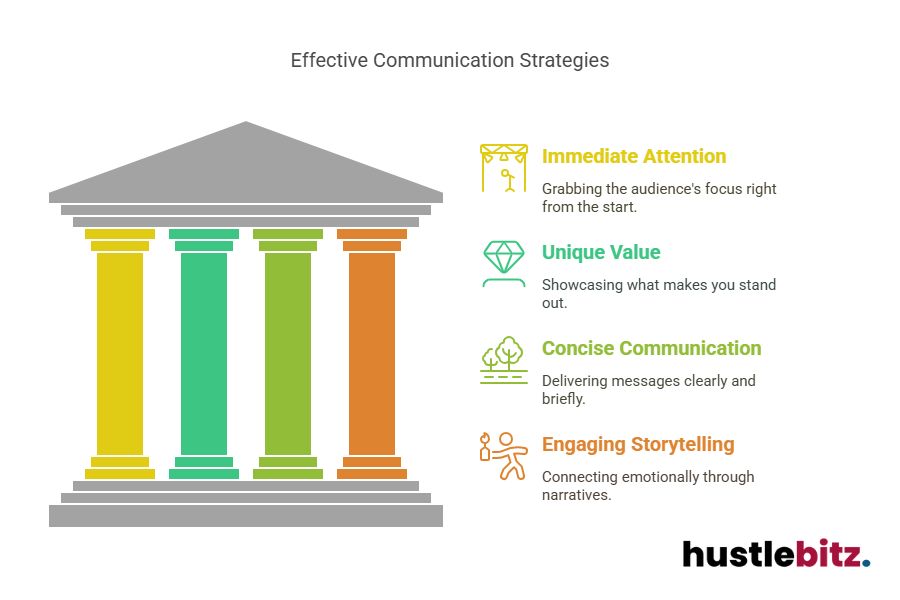Crafting an elevator pitch in 30 seconds requires brevity and precision. Start with an engaging opening to capture attention immediately. Tailor your message to your target audience by understanding their needs and using relevant industry language. Highlight your unique value proposition by briefly discussing key skills and achievements. Use vivid yet straightforward language to ensure clarity and impact. Practice your delivery with a focus on confident body language and vocal modulation. Preparation and refinement lead to a polished and persuasive pitch. For a deeper understanding of crafting a standout elevator pitch, keep exploring.
Key Takeaways
- Capture Immediate Attention: Start with a hook or intriguing statement to instantly engage your audience.
- Highlight Unique Value: Clearly articulate what sets you apart from others in your field.
- Concise Communication: Deliver your core message in a few impactful sentences, avoiding unnecessary details.
- Engaging Storytelling: Use relatable and memorable narratives to create an emotional connection.
- Strong Conclusion: End with a powerful statement or call to action to leave a lasting impression.

Understanding the Elevator Pitch

An elevator pitch is a succinct and compelling summary of an idea, product, or oneself, typically delivered within the span of an elevator ride. Mastery of this skill hinges on understanding several key components that elevate the pitch from rudimentary to impactful.
Foremost is the importance of brevity. In an era where attention spans are fleeting, distilling your message to its core essence ensures it is both digestible and memorable. Brevity, however, should not come at the expense of substance. Balancing conciseness with content necessitates a sharp focus on the most compelling aspects of your proposition.
Engaging storytelling is another critical element. Humans are naturally drawn to narratives, so weaving a brief but captivating story into your pitch can significantly enhance its allure. This approach humanizes your message, making it relatable and memorable.
Confidence building is equally vital. Confidence can transform a mundane delivery into a persuasive performance. Preparation and practice are the bedrocks of confidence, enabling you to present your pitch with poise and assurance.
Body language plays a pivotal role in reinforcing your verbal message. Non-verbal cues, such as eye contact, facial expressions, and posture, can convey enthusiasm, sincerity, and professionalism, all of which bolster the overall impact of your pitch.
Lastly, adapting tone to suit your audience and context is crucial. An adaptable tone ensures that your pitch resonates with diverse audiences, whether in a corporate boardroom or a casual networking event.
Mastery of these components—brevity, storytelling, confidence, body language, and adaptable tone—forms the foundation of an effective elevator pitch.
Identifying Your Target Audience
Understanding the foundational elements of an elevator pitch sets the stage for the next critical step: identifying your target audience. A well-crafted pitch is ineffective if it fails to resonate with its intended audience. To achieve this resonance, one must first clearly define their target demographics. Consider factors such as age, profession, industry, and geographic location. These elements help in tailoring your message to those who are most likely to find it relevant.
Industry relevance is another crucial consideration. Different industries have unique challenges, opportunities, and jargon. By understanding these nuances, you can fine-tune your pitch to address specific industry pain points, thereby demonstrating your expertise and increasing your credibility. Remember, the goal is to make your pitch not only engaging but also highly pertinent.
Next, delve into the audience needs. Understanding what your audience is looking for enables you to align your pitch with their expectations and demands. Whether they seek innovation, efficiency, or profitability, your pitch should reflect how you can meet these needs effectively.
Engagement techniques play a pivotal role in maintaining the attention of your audience. Use compelling stories, statistics, or questions to capture interest and foster a connection. The more engaged your audience is, the more likely they are to remember and act on your pitch.
Lastly, incorporate feedback mechanisms to refine your pitch continuously. Seek feedback from colleagues, mentors, or industry professionals and use this input to make iterative improvements. This approach ensures that your elevator pitch remains dynamic and adaptable, meeting the evolving demands of your target audience.
Outlining Your Core Message

Crafting a compelling elevator pitch hinges on clearly outlining your core message. This pivotal component forms the essence of your pitch and determines its impact. By focusing on clarity and concise communication, you can convey your value proposition effectively within the limited time frame. To achieve this, consider core message examples that demonstrate how to distill complex ideas into a succinct narrative.
First, establish an emotional connection with your audience. This can be achieved through storytelling techniques that resonate and engage on a personal level. For instance, sharing a brief anecdote about a challenge you overcame can humanize your message and create a memorable impression.
Second, maintain a clarity focus by stripping away any superfluous details. Your core message should be easily understood without requiring additional context. This means honing in on the most critical aspects of your experience or skills that align with the interests of your audience.
Third, ensure your communication remains concise. A well-crafted core message should be delivered in a few sentences, leaving no room for ambiguity. This requires a disciplined approach to word choice, emphasizing precision and brevity.
To help you outline your core message, keep these key points in mind:
- Emotional Connection: Use storytelling techniques to create a relatable and memorable narrative.
- Clarity Focus: Prioritize the most critical information, avoiding unnecessary complexity.
- Concise Communication: Craft your message to be brief yet impactful, ensuring every word counts.
Highlighting Unique Value Propositions

Highlighting your unique value propositions is essential to making your elevator pitch stand out. In a competitive marketplace, distinguishing yourself through well-articulated personal branding can significantly enhance your appeal to potential employers or clients. Your unique value propositions are the cornerstone of your competitive advantage, offering a narrative that sets you apart from others in your field. They should encapsulate what you bring to the table that no one else does, thereby creating a compelling reason for your audience to be interested in you.
Utilizing storytelling techniques can be particularly effective in this context. By weaving your unique value propositions into a concise and engaging story, you can create an emotional appeal that resonates with your audience. Stories are inherently memorable and can make complex ideas more accessible. For example, instead of simply stating that you have strong leadership skills, narrate a brief anecdote about a time you successfully led a project that overcame significant challenges. This not only illustrates your abilities but also humanizes you, making your pitch more relatable and impactful.
Moreover, your unique value propositions should clearly contribute to market differentiation. In other words, they should address specific needs or gaps within your industry or target market. This involves understanding the current market landscape and positioning yourself as a solution to existing problems. By doing so, you highlight how your skills and experiences are not just unique but also highly relevant and valuable.
Structuring Your Pitch
To effectively communicate your unique value propositions, a well-structured elevator pitch is paramount. A meticulously crafted pitch not only captures attention but also leaves a lasting impression. Here are the essential elements to consider for structuring your pitch:
Begin with an engaging opening. The first few seconds are crucial for grabbing your listener’s attention. An engaging opening should be both intriguing and relevant, setting the stage for what is to come. Whether it’s a thought-provoking question, a startling statistic, or a powerful personal anecdote, your opening must compel the listener to want to hear more.
Focus on concise storytelling. Your elevator pitch should tell a brief yet compelling story that encapsulates your personal branding. Highlight your key achievements, skills, and experiences in a narrative that flows logically and succinctly. Avoid unnecessary details and focus on the elements that best illustrate your professional journey and aspirations.
End with a memorable conclusion. To ensure your pitch is unforgettable, conclude with a strong, memorable statement that reinforces your main message. This could be a call to action, a summary of your unique value, or a confident assertion of your future goals. The aim is to leave your listener with a clear understanding of who you are and what you bring to the table.
Key elements to remember:
- Engaging Openings: Capture attention immediately.
- Concise Storytelling: Communicate your message clearly and succinctly.
- Memorable Conclusions: Leave a lasting impression.
Additionally, confident body language is integral to delivering your pitch effectively. Stand tall, make eye contact, and use deliberate gestures to convey assurance and professionalism.
A well-structured pitch, delivered with confidence, can significantly enhance your personal branding and open doors to new opportunities.
Choosing Powerful Words

Incorporating vivid imagery into your pitch can also enhance its effectiveness. Descriptive phrases like “crafted a seamless user experience” or “engineered a robust cybersecurity solution” paint a clear picture of your skills and achievements. This kind of language can help your audience visualize your contributions and understand their significance.
Concise language is equally important in an elevator pitch. Given the limited time, every word must serve a purpose. Avoid jargon and complex terminology that might confuse your listener.
Instead, opt for straightforward, impactful words that clearly convey your message. For example, replace “utilized” with “used” or “facilitated” with “led” to make your pitch more digestible.
Practicing Your Delivery

Having chosen powerful words to craft a compelling elevator pitch, the next step is to focus on practicing your delivery. Achieving mastery in delivery requires meticulous attention to several key elements, including tone variation, body language, and pacing techniques, which together create a holistic and engaging presentation.
Tone variation is crucial in maintaining the listener’s interest and conveying enthusiasm. Modulating your voice to emphasize key points can make your message more impactful. Vocal clarity is equally important, ensuring that your words are easily understood without the need for repetition. Practice speaking slowly and clearly, enunciating each word to avoid any misunderstandings.
Body language serves as a non-verbal mode of communication that complements your spoken words. Maintaining eye contact, using purposeful gestures, and adopting an open posture can significantly enhance your credibility and connection with the audience. Avoid distracting movements or closed-off stances, as these can detract from your message.
Pacing techniques are essential in ensuring that your pitch is neither rushed nor dragging. A well-paced delivery allows your audience to absorb information and react appropriately. Practice delivering your pitch within the 30-second timeframe, adjusting your speed as necessary to strike a balance between brevity and detail.
To refine your delivery, establish feedback loops by seeking constructive criticism from trusted colleagues or mentors. Recording your practice sessions can also provide valuable insights into areas needing improvement.
- Tone Variation: Modulate your voice to emphasize key points.
- Body Language: Use eye contact, gestures, and posture to enhance credibility.
- Pacing Techniques: Balance speed and clarity to keep the audience engaged.
Final Thoughts
Crafting an effective elevator pitch requires careful attention to brevity, clarity, and impact. By focusing on capturing immediate attention, highlighting your unique value, and structuring your message for maximum effect, you can ensure your pitch resonates with your audience. Practice and refinement are essential to delivering your pitch confidently, using tone, body language, and pacing to engage and persuade. Whether you’re networking, seeking new opportunities, or introducing yourself in a professional setting, a well-crafted elevator pitch can open doors and leave a lasting impression.




